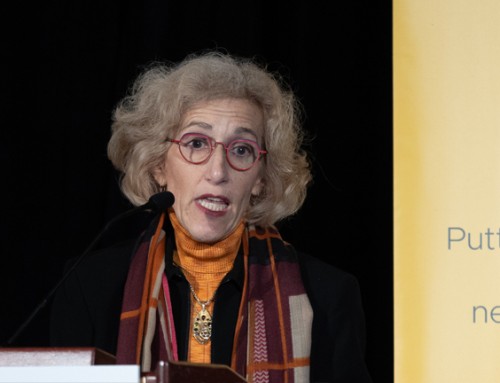Ten years ago, the Canadian Institutes of Health Research (CIHR) developed a Strategy for Patient-Oriented Research (SPOR). One of the foundations of SPOR is patient engagement, which is defined as “meaningful and active collaboration in governance, priority setting, conducting research and knowledge translation.”[1]
This blog will explore Family Engagement in Research (FER). More specifically, we’ll examine the issue of diversity among family partners in research.
As researchers, you’re keenly aware of the power of words to communicate. When seeking family research partners, consider the power of the preposition.
Your work can be done without a family partner. It would be easier, and it might be safer not to add any unnecessary complexity to your work.
However, engagement might be helpful for the families. Once you match a family partner’s interest in research with your expertise, you can walk alongside them. You become a great help to them in understanding their situation, and they benefit from serving a larger purpose.
Family partners can add to your research. The perspectives and insight that you harvest in FER will be much greater than anything you do on your own. But it would be best if you also considered how you could partner with families in research – as full partners.
Below, several barriers to having diverse FER are listed as a way of acknowledging that this is not a simple endeavour. FER with various family partners will add complexity and difficulty. However, we offer you creative solutions to break down these barriers in hopes that you consider how you can best partner with families in research.
What is diversity in FER, and why is it important?
One of CIHR’s guiding principles of patient engagement is inclusiveness: “patient engagement in research integrates a diversity of patient perspectives and research is reflective of their contribution.”1
What is meant by a “diversity of patient perspectives”? According to the Canadian Centre for Diversity and Inclusion, diversity is “about the individual. It is about the variety of unique dimensions, qualities and characteristics we all possess.”[2] Humans differ on many dimensions and characteristics, so how do you know which ones are important to consider for diversity in FER? The best place to start is with the factors that are known to influence health and access to health care:
- Age
- Gender
- Marital status
- Sexual orientation
- Income
- Education
- Employment
- Immigration status
- Race
- Culture
- Dis/ability
- Geography
Why should you care about diversity in FER, particularly when it will take time and energy to find diverse families? The UK’s Research Governance Framework for Health and Social Care states, “Research, and those pursuing it, should respect the diversity of human society and conditions and the multicultural nature of society…the body of research evidence available to policymakers should reflect the diversity of the population.”[3] Diversity in FER ensures that a wide range of views and lived experiences are reflected in the research process and, ultimately, the results. When your research is reflective of the population, it’s much more meaningful.
Barriers to diversity in FER[4] [5] [6]
Many barriers that reduce diversity in FER are relevant to engagement efforts generally. However, there are barriers for both researchers and families that specifically diminish opportunities for under-represented groups to be engaged in research.
Barriers in recruiting or engaging with more diverse families can be organized into structural, attitudinal, and personal categories.4
- Structural barriers are macro features of social, political and economic institutions or systems that historically have excluded and marginalized some groups.
- Attitudinal barriers are those that involve understandings, beliefs and assumptions about research, research systems and patients.
- Personal barriers involve contextual obstacles that are going to have more specific impacts on each individual.
| Researchers | Families/Patients | |
| Structural |
|
|
| Attitudinal/Cultural |
|
|
| Personal |
|
|
It’s also important to remember the intersectionality of many under-represented groups that can compound the difficulty in navigating multiple barriers. For example, some families may face obstacles related to transportation, costs, and expenses while also navigating complex systems that have not been safe historically.
Strategies to increase diversity in FER
FER is in its relative infancy in Canada. Certain conventions and modes of operation have taken root and contributed to the lack of diversity among family partners. To bring a more diverse range of people to the table, researchers and organizations will need to commit to new ways of “doing” FER. It will require creativity, resourcefulness and a willingness to take a few risks.
While every organization is different and all projects are unique, these strategies should help spark some ideas about overcoming the barriers discussed above.
- Tune in to power dynamics[7]
First impressions matter. Before your initial contact with prospective partners, consider how you and your organization will be perceived. Is an email written in the formal style/tone you use with your professional peers the right way to go? Or would reaching out with a friendly phone call be better?
If you’re attending a community event where you hope to connect with members, do a bit of investigating. Find out if there will be time for networking and if it will be considered appropriate, how people will dress, and anything else that might help you start on the right foot.
- Bend the rules[8]
Rethink how, where and when research is done. Attending meetings at your research home base in the middle of the workday is not an option for many people. So why not go to them? A familiar, relaxed setting can make a big difference. Or schedule meetings in the evening and make it easy to join remotely (including providing the technology, if necessary). Try to be flexible and adapt to the realities of families’ lives.
- Show partners that they’re valued
From day one, make a point of showing, not telling, family partners that they’re essential to your research. Build financial resources into your grant application to fairly compensate them beyond the baseline coverage of travel, parking and childcare. Whatever your budget is, make it clear what you can offer at the outset to enable them to make an informed decision about the feasibility of partnering. And don’t forget non-monetary recognition – acknowledge and encourage their contributions along the way.
- Choose your words carefully
Researchers speak their language. Leave the jargon and in-jokes at the door when engaging with family partners, especially those from communities that have never been involved in research. Instead, observe their ways of communicating, both in-person and online. Clear communication will help you avoid relationship deal-breakers like mistrust and confusion. You may even have to start using some new social media platforms if that’s a preferred mode of connecting.
- Build relationships first
Put time and effort into laying the groundwork for a meaningful partnership. Going straight to the ask when you meet potential family partners from underrepresented groups is a big mistake. Why would they agree to help you when they have no prior experience of this kind of arrangement and no foundation of trust with you and your organization? Please do your research on them (follow their social media presence, read community group newsletters, attend events, etc.), so you have some common ground. Most important, find an opportunity to listen to their priorities and concerns. Then start the conversation.
Next steps
When you feel ready to start reaching out to more diverse family partners, here are a few practical tips based on the strategies above:
- Attend public events (virtual or otherwise) held by patient/family groups, or request invitations if they’re not public
- Ask to join relevant social media groups
- Write an article summarizing your research in lay language and submit it to relevant publications
For more detailed “how-to” information, consider these resources:
Recruiting for diversity (hqontario.ca)
Tips and tools for reaching out, including an email template
Institute for Patient- and Family-Centered Care (IPFCC) guide on how to find and keep diverse patient and family advisors, including sample communication materials
A 2020 article from the journal Research Involvement and Engagement with guidance on how to best engage Indigenous patient partners in research
Strategies for diversity and inclusion in public involvement:
A list of ideas and information from the National Institute of Research about reaching out to members of the public who don’t often get involved in research.
A bite-size guide to Diverse and Inclusive Participation
A practical guide from the National Institute of Research England based on the NHS Citizen program.
[1] Strategy for Patient-Oriented Research – Patient Engagement Framework. (2019, May 27). CIHR. https://cihr-irsc.gc.ca/e/48413.html#a7
[2] Diversity Defined. (n.d.) Canadian Centre for Diversity and Inclusion. https://ccdi.ca/our-story/diversity-defined/
[3] Research Governance Framework for Health and Social Care, 2nd edition. (2005, April). Department of Health.
[4] Flynn, R., Walton, S., & Scott, S. D. (2019). Engaging children and families in pediatric health research: A scoping review. Research involvement and engagement, 5(1), 32.
[5] Hanover Research (2016). Best Practices in Engaging Diverse Families. Retrieved from: http://www.gssaweb.org/wp-content/uploads/2016/06/Hanover-Research-Spotlight-Best-Practices-in-Engaging-Diverse-Families.pdf
[6] Schnirer, L., & Stack-Cutler, H. (2012). Recruitment and engagement of low-income populations: service provider and researcher perspectives. Community-University Partnership for the Study of Children, Youth, and Families.
[7] Cowan, K. (2020) INVOLVE: A Practical Guide to Being Inclusive in Public Involvement in Health Research INVOLVE_RO_report_FINAL_180220.pdf
[8] INVOLVE, National Institute for Health Research (2012). Diversity and inclusion: What’s it about and why is it important for public involvement in research? INVOLVEDiversityandInclusionOct2012.pdf








